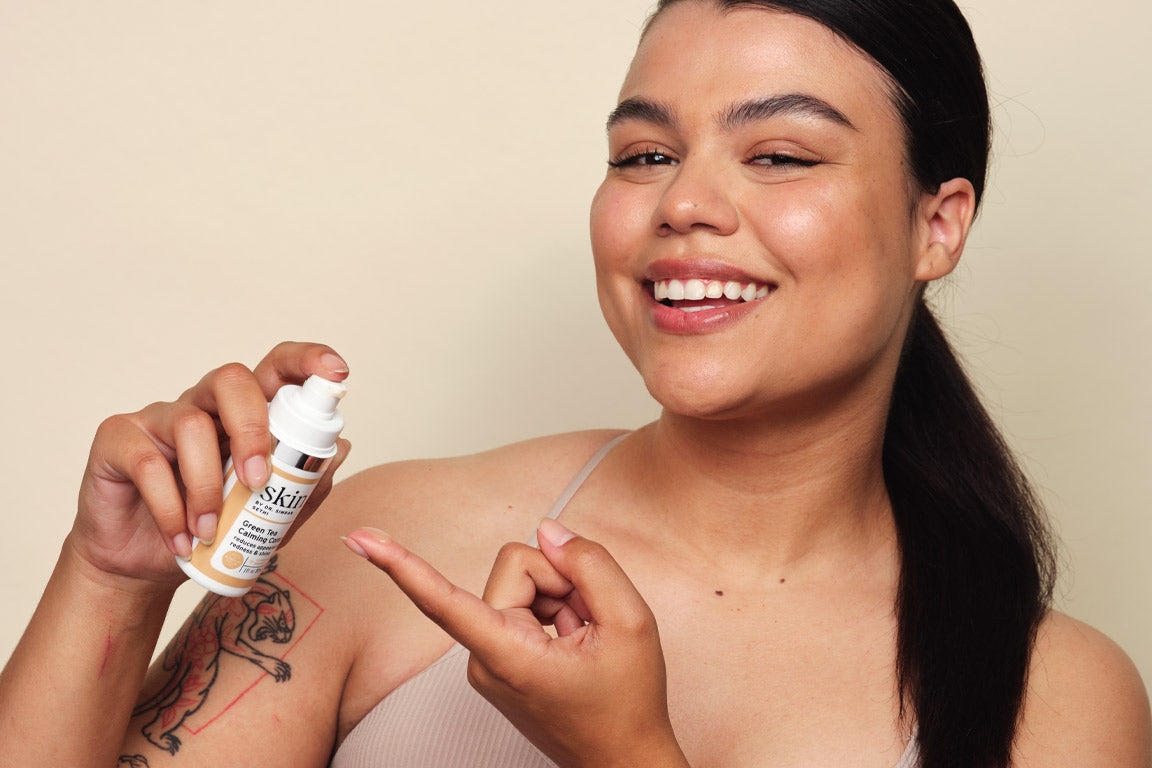The beauty industry is a flawed system, especially considering its exclusion of people of color with melanated skin. While beauty buyers can do their best to support brands that cultivate change, it is not the easiest feat to make waves at the consumer level. So, as we wait for the industry to make positive steps toward inclusivity, what can people of color do to meet their skin’s needs?
The answer is to take the power of knowledge into your own hands.
Skin care for people of color can involve treating different skin conditions that require specialized treatments. Fortunately, learning about the common conditions that people of color with melanated skin face can help them to nurture and treat their skin. On The Skin Report podcast, Dr. Simran Sethi, an Internal Medicine doctor and the Founder and Medical Director of RenewMD, informs listeners about the best ways to address common skin conditions of people of color.
The Key to Glowing Skin
The best way to maintain healthy and radiant skin is to understand the root cause if your skin’s conditions(s) and the most straightforward way to heal your skin instead of covering it up. While this is true for all skin tones, the beauty industry has historically failed to offer enough high-quality products and even clinically-proven reasearch for treating melanated skin.
Unfortunately, the lack of skin care resources for melanated skin stem’s from the beauty industry’s oversight which results in discrmination of a very large segment of skincare users. It has resulted in less knowledge about melanated skin concerns, as people of color are often excluded from skincare studies.
However, the Journal of the American Academy of Dermatology (JAAD) combined studies and determined the top three most common dermatological complaints in women of color: dyschromia, atopic dermatitis, and acne.
Treating Skin Conditions of People of Color
To enhance our knowledge on caring for melanated skin, let’s tackle the most common skin concerns that people of color face and explore ways to treat them that work with our melanin.
Dyschromia (aka discoloration)
If you have melanated skin and have ever experienced irregular or patchy discoloration, it may have been a form of dyschromia. Dyschromia is used to describe types of conditions that result in discolored skin. This can include melasma, hyperpigmentation, hypopigmentation, and vitiligo.
Cases of dyschromia can have different causes but are often due to melanin density variations or vascular changes in blood vessels. Other causes can include autoimmune diseases or post-inflammatory hyperpigmentation.
Treatments for dyschromia can vary based on the particular condition. For example, to treat post-inflammatory hyperpigmentation, try incorporating some of the following elements into your skincare routine:
- A gentle cleanser with AHAs to slough off dead skin cells and boost the cell turnover rate – revealing new layers of skin
- Serums with antioxidants like Vitamin C to help even out the skin tone.
- Sunscreen to protect the skin and prevent more hyperpigmentation.
Atopic Dermatitis (Eczema)
Atopic dermatitis, sometimes known as eczema, is a common skin concern that can flare up and disappear at different times and result from an overactive immune system. Flare-ups can be triggered or worsened by stress, lack of sleep, unhealthy eating, and failure to moisturize consistently. It can also be triggered by contact with irritating ingredients or allergens.
For people of color, eczema can appear purple, brown, or grayish and be itchy and dry. Atopic dermatitis in POC causes itchiness that, when scratched for relief, can aggravate the rash and cause post-inflammatory hyperpigmentation.
Fortunately, people of color can take steps to avoid and treat atopic dermatitis.
- Determine whether an allergen is triggering your skin. Seeing an allergist can help identify your triggers so you can avoid them.
- Moisturize daily with a strong but simple moisturizer that can handle atopic dermatitis without aggravating the skin.
- Prioritizing your physical and mental health to reduce outbreaks and help to restore the skin.
Acne
Acne can be a stubborn, prevalent issue, even in adulthood. To treat acne, people of color need to use methods that work with their melanin, but unfortunately, most acne products are made without this in mind. Harsh ingredients can aggravate the condition and cause hyperpigmentation, acne scars, and more issues in people of color.
Dr. Sethi recommends starting low and slow with active ingredients, especially for more melanated skin. Don’t forget that moisturization is still essential, and a balanced approach to oil reduction can help avoid inflammation and support melanin production.
Here are some ways people of color can safely treat their acne.
- Incorporate a low dose of retinol in their nighttime routine to help clear pores and reduce inflammation for clearer, brighter skin
- Melanated skin can also benefit from a low dosage of benzoyl peroxide, such as 2.5%, to help kill acne-causing bacteria.
- Opt for gentle cleansers and exfoliants, and always follow up with a moisturizer!
***
Cosmetic skin treatments can also help to rejuvenate the skin and remove the top layer to reveal more even skin underneath. As an internal medicine doctor and the founder of her medical spa, Dr. Sethi explains some of the popular treatments that she offers to help her patients get noticeable improvements for their dyschromia, acne, and hyperpigmentation from atopic dermatitis flare-ups. So listen to episode 19 of The Skin Report for more information on these conditions and the best ways to treat them!



